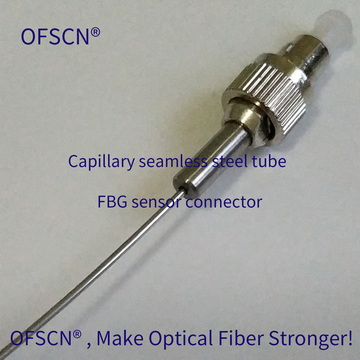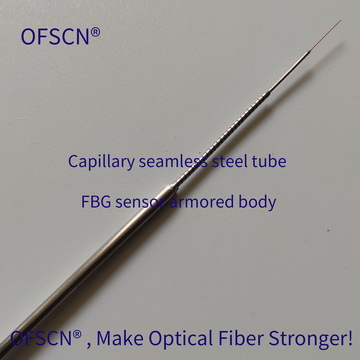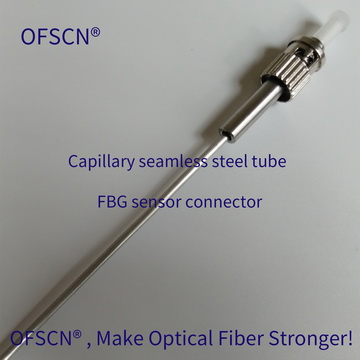FBG Sensor Working Temperature Range - FBG Thermometer Temperature Range - High/Low Temperature Resistance
Table of Contents:
Ⅰ. Concept of the Measurement Range for Fiber Bragg Grating Temperature Sensor
The measurement range of a Fiber Bragg Grating (FBG) temperature sensor refers to the temperature range in which the sensor can operate and perform temperature measurements effectively. It is also known as the sensor's operating range, temperature measurement range, or temperature tolerance.
Ⅱ. The Working Temperature Range of Fiber Bragg Grating Temperature Sensor Determined by Its Material Composition
The working temperature range of a Fiber Bragg Grating temperature sensor is determined by the materials used to construct the sensor, including the FBG itself and the encapsulation material. The temperature resistance of these materials collectively determines the measurement range of the Fiber Bragg Grating temperature sensor, which includes the highest and lowest temperatures the sensor can withstand.
Ⅲ. Avoiding Overloading: Fiber Bragg Grating Temperature Sensor Limitations
All OFSCN® capillary series Fiber Bragg Grating temperature sensors produced by DCYS have specified working temperature ranges, and they should not be used beyond their specified limits. Short-term, small-scale overloading may result in reduced repeatability and accuracy of the OFSCN® capillary series Fiber Bragg Grating temperature sensors, in which case, recalibration services can be provided by DCYS. Long-term, large-scale overloading may lead to irreparable damage to the OFSCN® capillary series Fiber Bragg Grating temperature sensors.
Ⅳ. Working Temperature Range (Measurement Range) of Seamless Steel Tube Encapsulated Fiber Bragg Grating Temperature Sensor
The patented OFSCN® Capillary Seamless Steel Tube series FBG Fiber Bragg Grating temperature sensors are primarily composed of seamless steel tubes and FBGs. There are currently four temperature grades available, with a minimum working temperature of -200 degrees Celsius and a maximum working temperature of 800 degrees Celsius.
1. OFSCN® 100°C Capillary Seamless Steel Tube FBG Fiber Bragg Grating Temperature Sensor:
Use UV mask writing FBG or FBG strings/arrays encapsuled in a stainless steel seamless steel tube. Standard working temperature range -40 to +100 degrees Celsius. Short-term working temperature range -60 to +150 degrees Celsius, allowing for repeated use in the -60 to +150 degrees Celsius range (continuous use in -40 to +100 degrees Celsius environment

This article introduces the working temperature range of the OFSCN® 100°C Capillary Seamless Steel Tube Fiber Bragg Grating (FBG) temperature sensor (FBG thermometer), including its maximum high-temperature endurance and maximum low-temperature values. It also describes the methods and principles for determining the working temperature range of fiber bragg grating temperature sensors (including the stainless steel materials used and the FBG written using ultraviolet lithography).
2. OFSCN® 300°C Capillary Seamless Steel Tube FBG Fiber Bragg Grating Temperature Sensor:
Use UV mask writing FBG or FBG strings/arrays encapsuled in a stainless steel seamless steel tube. Use FBG or FBG strings/arrays which are UV mask written and encapsuled in stainless steel seamless tubes. Standard working temperature range -200 to +300 degrees Celsius. Short-term working temperature range -200 to +350 degrees Celsius, allowing for repeated use in the -200 to +350 degrees Celsius range (continuous use in -200 to +300 degrees Celsius environment).

This article introduces the working temperature range of the OFSCN® 300°C Capillary Seamless Steel Tube Fiber Bragg Grating (FBG) temperature sensor (FBG thermometer), including its maximum high-temperature endurance and maximum low-temperature values. It also describes the methods and principles for determining the working temperature range of fiber Bragg grating temperature sensors (including the stainless steel materials used and the femtosecond fiber bragg grating).
3. OFSCN® 600°C Capillary Seamless Steel Tube FBG Fiber Bragg Grating Temperature Sensor:
Use Femtosecond laser point-by-point writing FBG or FBG strings/arrays encapsuled in a stainless steel seamless steel tube. Standard working temperature range -200 to +400 degrees Celsius. Short-term working temperature range -200 to +400 degrees Celsius, allowing for repeated use in the -200 to +400 degrees Celsius range (continuous use in -200 to +600 degrees Celsius environ

This article introduces the operating temperature range of the OFSCN® 500°C Capillary Seamless Steel Tube Fiber Bragg Grating Temperature Sensor (FBG Thermometer), including its maximum high-temperature and low-temperature resistance values. It also discusses the determination method and principles of the operating temperature range of fiber Bragg grating temperature sensors, including the stainless steel material and femtosecond fiber bragg grating used.
4. OFSCN® 800°C Capillary Seamless Steel Tube FBG Temperature Sensor:
Use Femtosecond laser point-by-point writing FBG or FBG strings/arrays encapsuled in a stainless steel seamless steel tube. Standard working temperature range -269 to +800 degrees Celsius. Short-term working temperature range -269 to +1000 degrees Celsius (duration unknown).

This article introduces the working temperature range of the OFSCN® 800-degree Celsius capillary seamless steel tube fiber bragg grating temperature sensor (FBG thermometer), including the values for its maximum high-temperature and low-temperature resistance. It also discusses the methods and principles used to determine the working temperature range of fiber bragg grating temperature sensors, including the stainless steel material and femtosecond fiber bragg grating used.
Ⅴ. Working Temperature Range (Measurement Range) of Low Voltage Insulated Fiber Bragg Grating Temperature Sensor
The patented OFSCN® capillary series low voltage insulated FBG temperature sensors produced by DCYS, are primarily composed of insulating materials, seamless steel tubes, and FBGs. Currently, there are two common temperature grades available:
1. OFSCN® Capillary 170°C Low Voltage Insulated Seamless Steel Tube FBG Temperature Sensor:
Use insulating materials, and UV mask writing FBG or FBG strings/arrays encapsuled in a stainless steel seamless steel tube. Standard working temperature range -60 to +170 degrees Celsius.
2. OFSCN® Capillary 250°C Low Voltage Insulated Seamless Steel Tube FBG Temperature Sensor:
Use insulating materials, and UV mask writing FBG or FBG strings/arrays encapsuled in a stainless steel seamless steel tube. Standard working temperature range -100 to +250 degrees Celsius.
Ⅵ. Working Temperature Range (Measurement Range) of Ceramic Encapsulated Fiber Bragg Grating Temperature Sensor
The OFSCN® series insulated FBG Fiber Bragg Grating temperature sensors produced by DCYS are mainly composed of insulating ceramics and FBGs with different temperature grades. They are suitable for high-voltage and higher-temperature environments.
At DCYS, the OFSCN® series insulated FBG temperature sensors are divided into five temperature grades, where four of them can be referenced in the previous sections (1, 2, 3, 4). The fifth temperature grade is a super-high-temperature product, with a maximum working temperature of up to +1600 degrees Celsius. This product is custom-made and is not stocked in regular status. If needed, please contact for customization.
The structure of the Ceramic Encapsulated FBG temperature sensor can be seen in the article below:

Product Functions: Single/multipoint temperature detection under electrified state, temperature measurement; temperature compensation for strain and stress sensors.
Ⅶ. How is the Working Temperature Range (Measurement Range) of Fiber Bragg Grating Temperature Sensor Determined?
The high-temperature part of the temperature measurement range for various OFSCN® series FBG temperature sensors produced, as described above, is based on actual measurements and is relatively accurate. The low-temperature part (below -60 degrees Celsius) of the working temperature range is determined by theoretical calculations based on working experience and product material parameters (customers have tested these sensors down to -200 degrees Celsius in actual operations). The reason for using theoretical calculations in the low-temperature range is due to the unavailability of experimental conditions to test such low temperatures, and thus, the provided data is not measured data.
